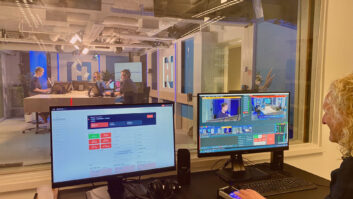NAMM 2008 Review: What’s for Radio?
Jan 23, 2008 10:10 AM, By Chriss Scherer, editor
Anaheim, CA – Jan 21, 2008 – The winter convention of the National Association of Music Merchandisers (NAMM) was held Jan. 17-20 in the Anaheim Convention Center. What does a music convention have for radio? It’s certainly not the typical radio and audio displays of the NAB convention, but there are several professional audio manufacturers showing items with uses for radio.
Portable mixers, portable PAs, mics, cables, connectors, amplifiers, adapters and similar items can be found between the endless guitar and drum displays. This year, portable recorders were plentiful, and many appear to have a suitable use in radio. With existing recorders from Zoom, Marantz, Denon, HHB, AEQ and Nagra setting the bar for features, several manufacturers are taking stabs at the market.
At the NAMM Show, Olympus, Tascam, Yamaha and Dynasonics all showed models of new handheld recorders. Belkin has also entered the recorder market.
Tascam unveiled the DR1, which looks similar to other portable stereo recorders already available. It features a built-in stereo condenser microphone with variable-angle mechanism, 48- or 44.1kHz 24-bit recording resolution, MP3 and WAV file capability, a switchable low-cut filter, a rechargable lithium-ion battery, and a USB 2.0 connector for file download. It can accept external mic or line inputs. Mic 1 in is via an 18″ connector, while mic 2 uses a 1/4″ connector. The unit measures 2.8″ x 1.1″ x 5.3″. While targeted to the music audience, it also features a built-in tuner and vocal cancel features, as well as an overdub feature, which could be useful. It records to SD media and includes a 1GB card.


Olympus has produced dictation recorders for some time, and has applied that experience to create the LS-10. The recorder features 2GB of internal storage, and it accepts SD media for additional storage. The unit will operate up to 12 hours on two AA batteries, and records in WAV, MP3 and WMA formats with up to 24-bit, 96kHz resolution. Additional features include a stereo mic pair and stereo speakers, mic and line inputs, a headphone output and a threaded stand fitting.
The smallest new recorder is the Yamaha Pockectrak 2G, measuring about 1.5″ wide, 4.75″ long and less than 0.5″ thick. It includes a rechargeable AAA nickel-hydrogen battery and 2GB of internal memory. The unit has a retractable USB connector for file transfer and power charging. Included is a USB extension cable, stereo earphones, a leather carrying case and stand adapter (a photo-mount thread is part of the case) and Cubase AI editing software. It records two tracks as PCM, MP3 or Windows Media formats. The stereo mic orientation can be adjusted.

The Dynasonics PDR-1 is yet another two-track recorder that includes two built-in mics, two lavalier mics and a set of ear buds. It comes with 128MB of memory but will accept up to 4GB. It records linear audio at 16-bit 44kHz and MP3s at 128kb/s. The unit has two 1/4″ inch mono jacks, one 1/8″ stereo line out jack, two 1/4″ line in/guitar mono jacks with volume controls, a USB port, a 1″ x 2″ LCD display, built-in monitor speakers, and includes a power adaptor.
Not in the same vein as the portable recorders noted above, but still interesting, Belkin showed a mixer/recorder unit called the Tunestudio. The unit records linear audio directly to an Ipod at 16-bit, 44.1kHz. The mixer can also streams audio through its USB interface. Each channel has a three-band EQ, pan and level controls, the mic inputs include phantom-power, and a stereo compressor is included. Inputs 1 and 2 are mono mic or line, input three is a balanced stereo input and input four is an unbalanced stereo input. There are headphone and monitor outputs. Belkin also has a smaller variation in the works that comes closer to a handheld unit.












